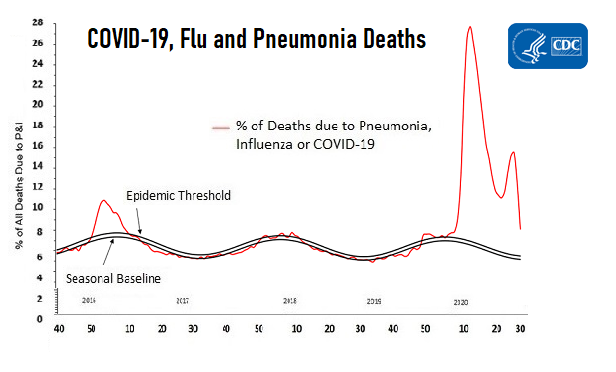 (Credit: CDC)
(Credit: CDC)
The latest COVID-19 tracking numbers from the U.S. Centers for Disease Control and Prevention (CDC) show that U.S. death counts continue to be about 10% higher than the expected numbers.
The United States records about 2.8 million deaths per year in an ordinary year, and an average of about 54,000 deaths per week. If the overall U.S. death total stayed about 10% higher than normal, that would mean the United States was recording about 5,500 excess deaths per week, and about 22,000 excess deaths per month.
The CDC provides total death numbers, and actual-to-expected ratios, for both the country as a whole and individual deaths, to compensate for challenges with COVID-19 testing and testing data.
Resources
- The CDC’s weekly COVID-19 report is available here.
- The COVID Tracking Project at The Atlantic is available here.
- The HHS hospital capacity data is available here.
- An overview article about the COVID-19 data for the previous week is available here.
The CDC has based its reporting system for COVID-19 on the reporting system it uses for influenza, and it generally assumes that early cases of COVID-19 will resemble the flu.
The agency depends on states to report the death data and other, related figures, and each state sends in numbers in its own format, on its own schedule. Because of the data reporting delays and inconsistencies, the death numbers take at least a month to start to firm up.
The very latest CDC death numbers, for the week ending Aug. 13, show that the ratio of deaths resulting from COVID-19 and conditions that look like COVID-19, such as flu and pneumonia, soared to about 16% during the week ending July 25, or the 30th week of the CDC’s influenza reporting year. That’s about twice the epidemic level for the ratio of deaths from flu-like illnesses to total deaths.
Aside from April and May, when a severe epidemic in New York City sent weekly totals there to more than four times the normal levels for four weeks, the national July 25 ratio of deaths from flu-like illnesses to total deaths appears to be the highest since the CDC began reporting the data in that format, and possibly the peak of the 1968 Hong Kong flu.
New York City accounts for about 40% of the population of New York state. When the COVID-19 pandemic was peaking in New York City, the ratio of total deaths to expected deaths increased to more than 50% higher than the usual level for seven weeks,. During the week ending April 11, the total number of deaths throughout New York state was 2.36 times the expected number.
Connecticut, Delaware, Louisiana, Maryland, Massachusetts, Michigan, New Jersey, Rhode Island and the District of Columbia also had death totals that were 50% higher than normal for two or more weeks. All of those outbreaks eased below the 50% increase threshold by May 30.









 August 17, 2020 at 05:45 PM
August 17, 2020 at 05:45 PM











